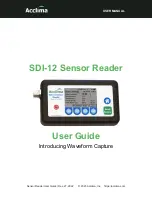
3... I
NTERFACE
M
ODULES
U
SING THE
OMP-MODL
3-35
Frequency Signal Connection:
To utilize an MLIM-2 channel as a Frequency input, connect the input signal
positive lead to one of the four
Input
terminals (Chan A, B, C, or D) and the
negative lead to one of the four
Common
terminals on the module terminal
strip (Figure 3... -23). Note that all of the four Common terminals are
interconnected and connect directly to the OMP-MODL circuit ground..
Refer to Chapter 7 for steps to generate a Terminal Strip Wiring printout for
use in making field wiring connections.
CAUTION:
Note that a direct connection exists between
the common (-) terminal on all four channels of the MLIM-
2 (
Figure 3... -22). When connecting to multiple frequency
sources sharing a common ground or reference, insure
that the source’s ground or reference is connected to the
terminal strip `common’ terminal to prevent shorting out
of the frequency signal and possible damage to the
MLIM-2.
For Frequency recording applications with small signal amplitude, high
frequencies, long lead length and/or in noisy environments, twisted pair wire
will provide extra noise immunity. In extremely noisy applications, shielded
wire may be required. If shielded wire is used, the shield at the OMP-MODL
end should be connected to an external earth ground (Figure 3... -23) or if
available, a grounded Shield connection provided on another type installed
interface module (such as the MLIM-1).
NOTE: Do not ground the shield wire at the end away from the OMP-MODL.
Terminal Strip
Earth Ground
ML060
+
-
Shielded Twisted
Pair Lead
Shield
+
-
Channel A
Channel B
Common
Channel C
Channel D
Frequency
Source A
Frequency
Source B
1 2 3
4 5
6
Figure 3... -23: Frequency input terminal strip connections (two inputs shown)
Summary of Contents for OMP-MODL
Page 1: ......
Page 9: ...1 INTRODUCTION USING THE MODULOGGER 1 7 13 ...
Page 23: ...2 OMP MODL System Base Using the OMP MODL 2 14 NOTES ...
Page 24: ...2 ModuLogger System Base Using the ModuLogger 2 1 ...
Page 30: ...3 INTERFACE MODULES USING THE OMP MODL 3 6 NOTES ...
Page 70: ...3 INTERFACE MODULES USING THE OMP MODL 3 46 NOTES ...
Page 76: ...3 INTERFACE MODULES USING THE OMP MODL 3 52 NOTES ...
Page 82: ...3 INTERFACE MODULES USING THE OMP MODL 3 58 NOTES ...
Page 83: ...3 INTERFACE MODULES USING THE MODULOGGER 3 1 ...
Page 105: ...5 HYPERCOMM COMMUNICATIONS USING THE OMP MODL 5 18 NOTES ...
Page 106: ...5 HYPERCOMM COMMUNICATIONS USING THE MODULOGGER 5 1 ...
Page 117: ...6 PCMCIA CARD CONFIGURATION AND USE USING THE MODULOGGER 6 1 ...
Page 134: ...7 HYPERNET ICON BASED PROGRAMMING USING THE OMP MODL 7 17 NOTES ...
Page 141: ...8 P P C D U OMP MODL ...
Page 149: ...9 HYPERPLOT GRAPHIC DATA DISPLAY USING THE OMP MODL 9 8 ...
Page 161: ...10 HYPERTRACK REAL TIME DATA DISPLAY USING THE OMP MODL 10 12 NOTES ...
Page 162: ...10 HYPERTRACK REAL TIME DATA DISPLAY USING THE OMP MODL 10 1 ...
Page 163: ...11 APPENDICES USING THE OMP MODL 11 1 11 APPENDICES ...
Page 164: ...11 APPENDICES USING THE OMP MODL 11 2 NOTES ...
Page 270: ...11 APPENDIX A MASTER ICON FILE REFERENCE USING THE OMP MODL 11 108 ...
Page 276: ...11 APPENDIX C HYPERWARE FILE LISTING USING THE OMP MODL 11 114 NOTES ...
Page 278: ...11 APPENDIX C HYPERWARE FILE LISTING USING THE OMP MODL 11 116 NOTES ...
Page 279: ......
Page 282: ...11 APPENDIX E CHANGING THE OMP MODL EPROM USING THE OMP MODL 11 120 NOTES ...
Page 288: ...11 APPENDIX G HYPERNET THEORY OF OPERATION USING THE OMP MODL 11 126 NOTES ...
Page 290: ...11 APPENDIX I RS 232 CABLE PORT AND ADAPTER USING THE OMP MODL 11 128 NOTES ...
Page 297: ...11 APPENDIX K MODEM CONFIGURATION USING THE OMP MODL 11 135 ...
















































